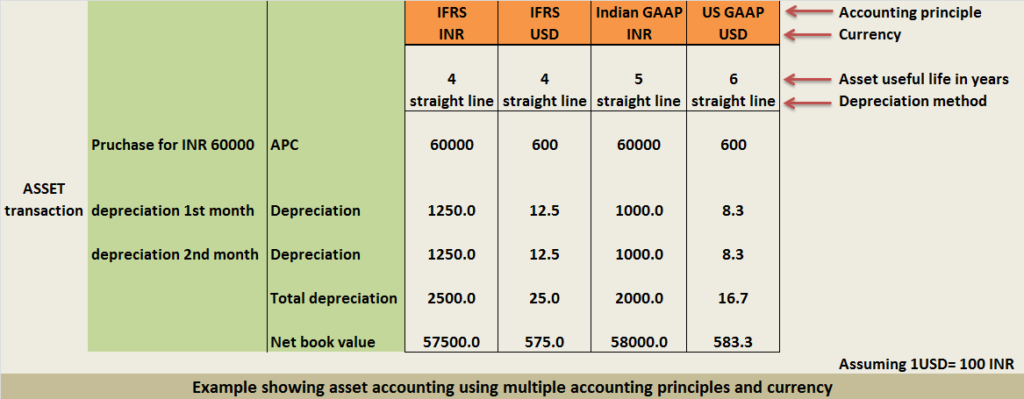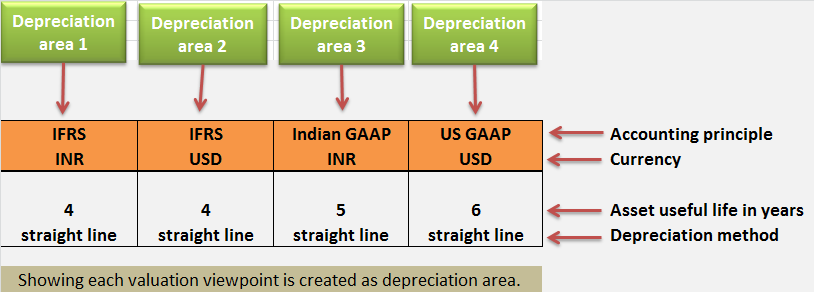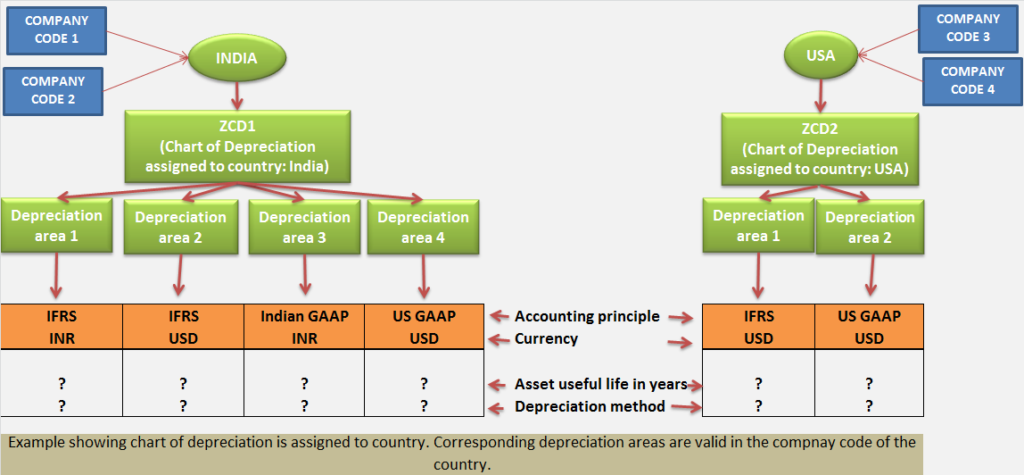Lets understand depreciation area and chart of depreciation with the help of examples. Consider below scenario:
Group Company is in USA and subsidiary company is in India.
Company code in India is required to perform asset accounting in multiple accounting principles as discussed below:

- Every company needs to present financial report using local accounting principle in local currency for local authority. In above example: Indian subsidiary needs to prepared financial report (balance sheet and P&L) as per Indian GAAP (Indian accounting principle) in currency INR for Indian authority. Hence asset accounting needs to be performed using Indian GAAP in INR.
- Company is required to produce financial report as per international accounting standards (IFRS) as well. Hence asset accounting needs to be performed using IFRS in INR.
- Group company needs to produce consolidated financial report in USD:
→Using accounting principle US GAAP for US authorities
→Using accounting principle IFRS as per international standards.
For consolidation to happen at group level, Indian subsidiary needs to perform asset accounting using US GAAP in USD and IFRS in USD.
In order to fulfill various requirements, Same asset needs to be managed using different accounting principle and currency.
Hence Indian subsidiary should be able to carry out asset accounting in multiple accounting principles and currency.
Let’s take example to understand the requirement better
Indian subsidiary purchases an asset for 60,000 INR.
Each month asset is depreciated.

Asset accounting requirement:
Asset needs to be managed using multiple accounting principles and currency. Each accounting principle may recommend different useful life and method of depreciation. In our example, only useful life is different but method of depreciation is kept same for understanding purpose.
As can see, transactions (asset purchase & asset depreciation) are valuated in four different view point (IFRS+INR, IFRS+USD, Indian GAAP+INR & US GAAP+USD).
Similarly, each transaction will be valued in four different viewpoints.
In SAP, the viewpoint in which asset needs to be valued is referred as Depreciation Area. To be able to achieve above asset accounting requirement in sap, we need to create multiple depreciation areas.

Indian company code requires above depreciation area but company code in USA may not require asset accounting in Indian GAAP.
Company code in USA may require asset accounting as per below.
→Using accounting principle IFRS as per international standards in currency USD.
→Using accounting principle US GAAP for US authorities in currency USD.
Depreciation areas needed for company code in USA is different from company code in India.
Hence the number of depreciation areas needed for asset accounting in a company code depends upon the country to which the company code belongs.
The list of depreciation areas applicable to a country is referred as Chart of Depreciation.
Chart of depreciation is basically list of all the depreciation areas which are applicable in a country. Depreciation area in the chart of depreciation is applicable to all the company codes belonging to the country.
Asset in a company code can be managed in depreciation areas of chart of depreciation which is assigned to country.

Asset in company code 1 and company code 2 can be valued in four different valuation viewpoints (depreciation area).
Asset in company code 3 and company code 4 can be valued in two different valuation viewpoints (depreciation area).
Different accounting principles may recommend different useful life and method of depreciation for the same asset. Hence an asset can have different useful life in depreciation areas.
Depreciation method (linear depreciation, double depreciation, accelerated depreciation etc.) is captured in depreciation key in sap. Depreciation key encompasses rules for depreciation calculation.
Depending upon the accounting principle, appropriate depreciation key is maintained in depreciation areas.
GL ACCOUNTING
- What is SAP FICO ?What business requirement is fulfilled in this module?
- What is enterprise structure in sap fico?
- What is GL account? What is account group? What is operational chart of accounts?
- What is the need of country chart of account or alternate chart of account? How country chart of account helps fulfill a business requirement?
- What is the need for group chart of account? How group chart of account helps in consolidation of financial data?
- What is non leading ledger in sap fico?
- What is company code global settings? What global parameter is assigned to company code?
- What is fiscal year variant? Why fiscal year variant is assigned to company code?
- What is posting period variant? Why posting period variant is assigned to company code?
- What is field status variant? What is field status group?
- What is document type in sap? Explain the purpose of document type?
- Document date vs Posting date vs Entry date vs Translation date. Explain
- What is posting key? what is the use of posting key?
- Document header & line items capture information of business transaction.
- Everything about currency & exchange rate in sap.
- Foreign currency valuation in sap. Explain with example
- Retained earnings account helps in year end balance carry forward. Explain
- What is the significance of tolerance groups in sap?
- What parameters are maintained in GL master and how does it impact in document posting?
ACCOUNTS PAYABLE
- What is meant by accounts payable in sap?
- Understanding procure to pay (PTP) cycle and accounting document at each step.
- Understanding MM FI integration in very simple terms.
- Purchase order price determination in SAP. Explained in very simple words.
- House bank, Bank key, Account ID in SAP
- What configuration (FBZP) needed for executing F110 in sap ?
ACCOUNTS RECEIVABLE
- How sap overcomes challenges in accounts receivable process?
- What is customer reconciliation account?
- Understanding order to cash cycle in sap.
- Understanding SD FI integration in very simple terms.
- What is lock box? How lockbox helps in collection from customers?
TAX ACCOUNTING
- How sap helps in tax accounting?
- Tax configuration in sap: Tax procedure, Tax code & Tax jurisdiction code
- Concept of tax jurisdiction code & tax jurisdiction structure
- Significance of “Tax category & Posting without tax allowed” in GL master.
- Tax base amount and Discount base amount
- Assigning tax code V0 & A0 for non taxable transaction?
- Deductible input tax vs non deductible input tax
WITHHOLDING TAX
- Withholding tax in sap explained with example.
- How sap overcomes challenges in managing withholding tax?
- Withholding at the time of invoice or payment
- Withholding tax configuration in sap
- Business place & Section code in sap
- Withholding tax certificate numbering in sap
- Withholding tax report for filling tax returns
ASSET ACCOUNTING
- How sap helps in asset accounting?
- What is meant by asset accounting?
- What is the use of asset class?
- What is the use of depreciation key in asset accounting?
- Depreciation area and Chart of depreciation in sap.
- Derived depreciation area VS real depreciation area?
- Understanding asset accounting configuration needed in sap
- GL account determination for posting asset transaction
- Asset transaction and corresponding accounting document?
- How depreciation is posted in sap?
SAP CONTROLLING